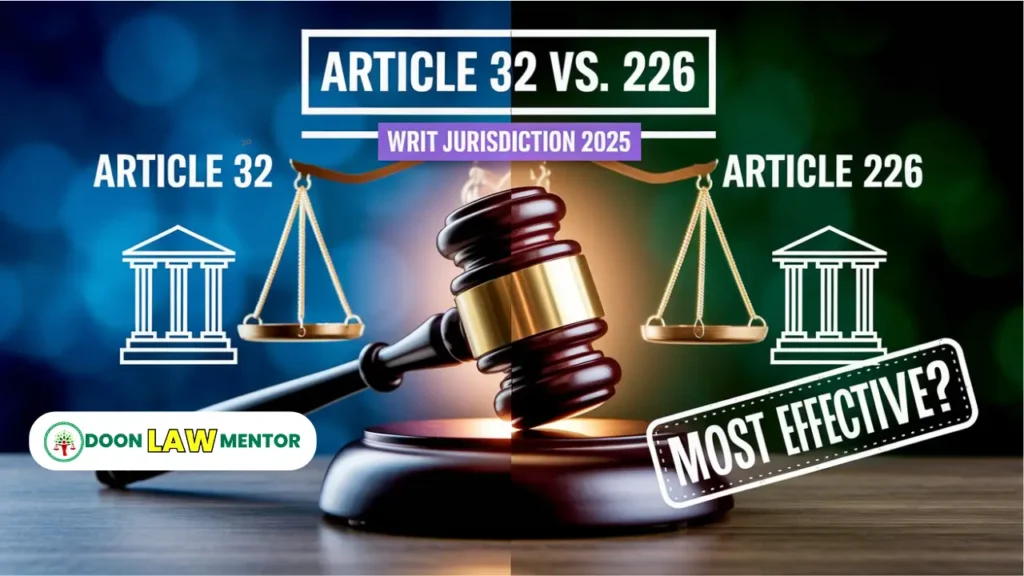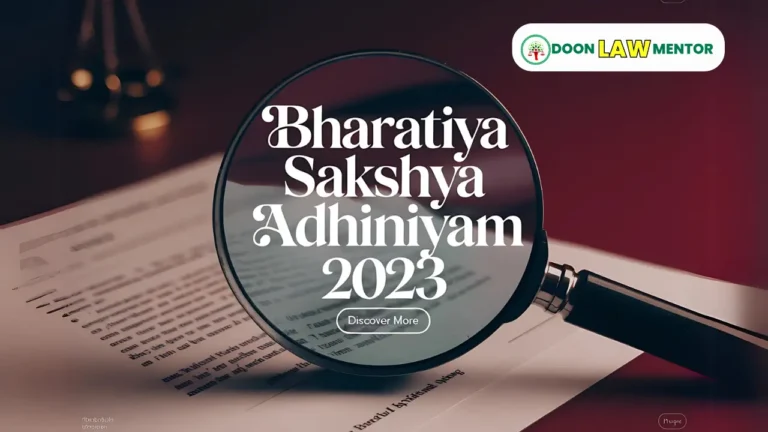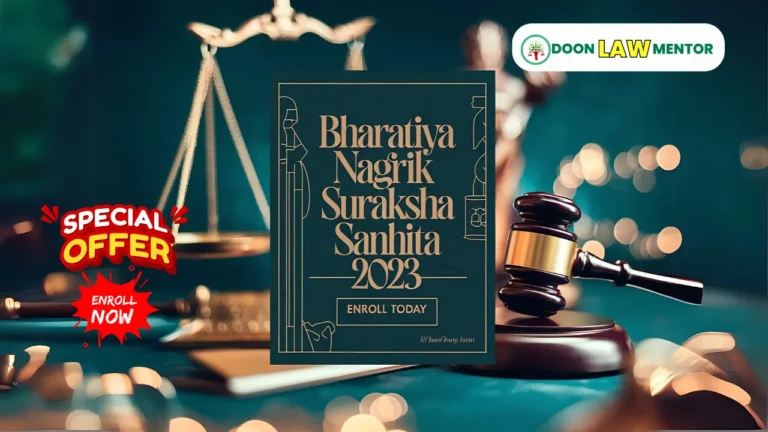Explore Article 32 vs. Article 226 to determine which writ jurisdiction is more effective for protecting fundamental rights in India. This blog compares their scope, accessibility, and recent legal trends, offering insights for law students and lawyers. Stay updated as of March 19, 2025!
Table of Contents
Introduction
The Indian Constitution provides powerful tools to protect fundamental rights through writ jurisdictions under Article 32 vs. Article 226. Article 32 empowers the Supreme Court to issue writs for the enforcement of fundamental rights, while Article 226 grants High Courts broader powers to issue writs for both fundamental rights and other legal rights. As of March 19, 2025, the debate over Article 32 vs. Article 226 and which writ jurisdiction is more effective remains a critical topic for law students, lawyers, and judicial aspirants.
In 2025, with evolving legal challenges like digital privacy, environmental justice, and healthcare access, understanding the effectiveness of Article 32 vs. Article 226 is more relevant than ever. This blog compares their scope, accessibility, procedural differences, and recent legal trends to determine which writ jurisdiction is more effective in 2025. Let’s dive into the nuances of Article 32 vs. Article 226 and their impact on Indian jurisprudence.
1. Understanding Article 32: The Supreme Court’s Writ Jurisdiction
What is Article 32?
Article 32, often called the “heart and soul” of the Constitution by Dr. B.R. Ambedkar, empowers the Supreme Court to issue writs for the enforcement of fundamental rights guaranteed under Part III of the Constitution. It provides a direct remedy to citizens whose fundamental rights are violated, ensuring access to the apex court.
Key Features of Article 32
- Scope: Limited to the enforcement of fundamental rights (e.g., Article 14—equality, Article 21—right to life).
- Writs Issued: Habeas Corpus, Mandamus, Prohibition, Certiorari, and Quo Warranto.
- Accessibility: Direct access to the Supreme Court, making it a fundamental right itself (as per Article 32(1)).
- Jurisdiction: Original jurisdiction, meaning cases can be filed directly in the Supreme Court without going through lower courts.
Landmark Cases Under Article 32
- Romesh Thappar v. State of Madras (1950): The Supreme Court struck down a law banning a communist journal, affirming freedom of speech under Article 19 via Article 32.
- Puttaswamy v. Union of India (2017): The right to privacy was recognized as part of Article 21, with Article 32 enabling the Supreme Court to issue directives.
Article 32 in 2025
In 2025, Article 32 remains a vital tool for addressing violations of fundamental rights, especially in cases involving national significance—e.g., digital privacy concerns arising from the UIDAI-Sarvam AI partnership (March 18, 2025) for Aadhaar voice authentication. However, its effectiveness is often debated due to procedural challenges, which we’ll explore in the comparison of Article 32 vs. Article 226.
2. Understanding Article 226: The High Court’s Writ Jurisdiction
What is Article 226?
Article 226 empowers High Courts to issue writs not only for the enforcement of fundamental rights but also for “any other purpose,” giving them a broader scope than Article 32. This makes High Courts more accessible for a wider range of legal grievances.
Key Features of Article 226
- Scope: Covers both fundamental rights and other legal rights (e.g., contractual disputes, administrative issues).
- Writs Issued: Same as Article 32—Habeas Corpus, Mandamus, Prohibition, Certiorari, and Quo Warranto.
- Accessibility: High Courts are geographically closer and more numerous (25 High Courts in India), making them more approachable.
- Jurisdiction: Original jurisdiction, but appeals from High Court decisions can go to the Supreme Court.
Landmark Cases Under Article 226
- State of Uttar Pradesh v. Raj Narain (1975): The Allahabad High Court used Article 226 to set aside Indira Gandhi’s election, showcasing its power to address legal rights beyond fundamental rights.
- L. Chandra Kumar v. Union of India (1997): The Supreme Court held that High Courts’ writ jurisdiction under Article 226 is part of the Constitution’s basic structure, emphasizing its significance.
Article 226 in 2025
In 2025, Article 226 has been instrumental in addressing local and regional issues, such as environmental concerns (e.g., Indore’s green waste plant under Swachh Bharat Mission, March 2025) and healthcare access (e.g., Ayushman Bharat MoU in Delhi, set for April 10, 2025). Its broader scope makes it a go-to option for many petitioners, but how does it fare in the Article 32 vs. Article 226 debate?
3. Comparing Article 32 vs. Article 226: Key Differences
To determine which writ jurisdiction is more effective in 2025, let’s compare Article 32 vs. Article 226 across several parameters:
3.1 Scope of Jurisdiction
- Article 32: Limited to fundamental rights. It cannot be invoked for violations of statutory or contractual rights unless they infringe on fundamental rights.
- Article 226: Broader scope, covering both fundamental rights and other legal rights. For example, a High Court can issue a writ under Article 226 to enforce a contractual obligation if it involves public interest.
- Winner in 2025: Article 226, due to its wider applicability in addressing diverse legal issues, such as administrative lapses or local governance failures (e.g., Delhi’s closure of 160 Mohalla Clinics, March 2025).
3.2 Accessibility and Reach
- Article 32: Direct access to the Supreme Court, but the court is located in Delhi, making it less accessible for petitioners from remote areas. Additionally, the Supreme Court’s heavy caseload often leads to delays.
- Article 226: High Courts are more accessible, with 25 High Courts across India. Petitioners can approach their state High Court, reducing travel and cost barriers.
- Winner in 2025: Article 226, as its geographical proximity and multiple forums make it more approachable for the common citizen, especially in urgent local matters like environmental pollution or healthcare access.
3.3 Nature of Remedy
- Article 32: A fundamental right itself, meaning the Supreme Court cannot refuse to entertain a petition under Article 32 if a fundamental right is violated. However, the court may decline to intervene if alternative remedies are available.
- Article 226: Discretionary power—High Courts can refuse to issue a writ if they deem it unnecessary or if alternative remedies exist. However, this discretion allows High Courts to address a wider range of issues.
- Winner in 2025: Article 32, as its mandatory nature ensures guaranteed access to justice for fundamental rights violations, especially in high-stakes cases like digital privacy or national security.
3.4 Speed and Efficiency
- Article 32: The Supreme Court’s backlog often delays hearings, though it can fast-track cases of national importance (e.g., privacy concerns with AI-driven surveillance in 2025).
- Article 226: High Courts generally have a faster disposal rate for writ petitions, especially for local issues. For instance, a High Court can quickly address a PIL on air pollution in a specific state.
- Winner in 2025: Article 226, due to its faster resolution of cases, making it more effective for urgent matters like environmental or healthcare crises.
3.5 Appeal and Finality
- Article 32: Decisions of the Supreme Court under Article 32 are final, with no appeal except through a review petition to the Supreme Court itself.
- Article 226: High Court decisions can be appealed to the Supreme Court under Article 136 (Special Leave Petition), providing an additional layer of scrutiny.
- Winner in 2025: Article 32, as its finality ensures quicker closure in fundamental rights cases, though Article 226’s appeal option can be beneficial for complex cases requiring further review.
4. Article 32 vs. Article 226 in 2025: Recent Legal Trends
4.1 Digital Privacy and Article 32
The Supreme Court has increasingly used Article 32 to address digital privacy concerns in 2025. For instance, the UIDAI-Sarvam AI partnership (March 18, 2025) for Aadhaar voice authentication raised privacy concerns, prompting PILs under Article 32. The Supreme Court’s ability to issue nationwide directives makes Article 32 more effective for such cases.
4.2 Environmental Justice and Article 226
High Courts have been proactive in 2025 under Article 226, addressing environmental issues like air pollution and waste management. For example, the Madhya Pradesh High Court may have used Article 226 to monitor the implementation of Indore’s green waste plant (March 2025), showcasing its effectiveness in local governance matters.
4.3 Healthcare Access and Both Articles
The Ayushman Bharat MoU in Delhi (set for April 10, 2025) has led to PILs under both Article 32 vs. Article 226. While Article 32 petitions in the Supreme Court focus on the national policy’s impact on the right to health (Article 21), Article 226 petitions in the Delhi High Court address local implementation gaps, highlighting the complementary roles of both provisions.
4.4 Hypothetical Case: Internet Shutdowns in 2025
In a hypothetical 2025 scenario, an internet shutdown in a conflict-prone area like Jammu & Kashmir could lead to petitions under both articles. An Article 32 petition in the Supreme Court might seek a nationwide policy on internet access as part of Article 21 (right to life), while an Article 226 petition in the J&K High Court could demand immediate restoration, showcasing Article 226’s speed and Article 32’s broader impact.
5. Which Writ Jurisdiction is More Effective in 2025?
The effectiveness of Article 32 vs. Article 226 in 2025 depends on the context:
- For National Issues: Article 32 is more effective due to the Supreme Court’s authority to issue nationwide directives, especially in cases involving digital privacy, national security, or uniform policy implementation (e.g., Ayushman Bharat).
- For Local and Urgent Matters: Article 226 is more effective, as High Courts can address regional issues like environmental pollution, healthcare access, or administrative lapses with greater speed and accessibility.
- For Fundamental Rights: Article 32 has an edge, as it’s a fundamental right itself, ensuring guaranteed access to the Supreme Court. However, Article 226’s broader scope often makes it a more practical choice for petitioners.
Critical Analysis
In 2025, Article 226 emerges as more effective overall due to its accessibility, speed, and broader scope. High Courts have been instrumental in addressing local challenges, such as environmental justice (e.g., Indore’s green waste plant) and healthcare (e.g., Delhi’s Mohalla Clinics). However, Article 32 remains indispensable for cases of national importance, such as digital privacy or systemic violations of fundamental rights. The complementary nature of Article 32 vs. Article 226 ensures a robust framework for justice in India.
6. Practical Implications for Lawyers and Law Students
- For Lawyers: Understanding Article 32 vs. Article 226 is crucial for choosing the right forum. For urgent local issues, file under Article 226 in the High Court; for national policy challenges, approach the Supreme Court under Article 32.
- For Law Students: This comparison is a key topic for judiciary exams in 2025. Focus on landmark cases, recent trends (e.g., digital privacy, environmental justice), and the procedural differences between Article 32 vs. Article 226.
- For Advocacy: Both articles offer opportunities to advocate for public interest—e.g., using Article 226 for local PILs on pollution or Article 32 for nationwide privacy reforms.
Table: Article 32 vs. Article 226 in 2025
| Parameter | Article 32 | Article 226 | Winner in 2025 |
|---|---|---|---|
| Scope | Fundamental rights only | Fundamental rights + other legal rights | Article 226 |
| Accessibility | Supreme Court (Delhi) | High Courts (25 across India) | Article 226 |
| Nature of Remedy | Mandatory (fundamental right) | Discretionary | Article 32 |
| Speed and Efficiency | Slower due to backlog | Faster for local issues | Article 226 |
| Appeal and Finality | Final (except review petition) | Appealable to Supreme Court | Article 32 |
Conclusion
The debate over Article 32 vs. Article 226 in 2025 highlights the complementary roles of these writ jurisdictions in protecting rights in India. While Article 32 ensures guaranteed access to the Supreme Court for fundamental rights violations, Article 226’s broader scope, accessibility, and speed make it more effective for most petitioners in 2025. Whether addressing local issues like environmental justice or national concerns like digital privacy, both Article 32 vs. Article 226 play a vital role in India’s legal framework. For law students and lawyers, understanding their nuances is key to effective advocacy and exam preparation. Stay informed, and leverage these provisions to uphold justice in 2025! For more legal insights, join Doon Law Mentor and elevate your knowledge.
Want to master topics like Article 32 vs. Article 226 for judiciary exams? Join Doon Law Mentor’s Courses for expert guidance, notes, and more! Follow @doonlawmentor on Instagram for the latest legal updates!
FAQs
- What is the difference between Article 32 vs. Article 226 in 2025?
Article 32 applies to fundamental rights and is filed in the Supreme Court, while Article 226 has a broader scope and is filed in High Courts. - Which writ jurisdiction is more effective in 2025—Article 32 vs. Article 226?
Article 226 is generally more effective due to its accessibility and speed, though Article 32 excels for national issues. - Can Article 32 and Article 226 be used for the same case in 2025?
Yes, but courts may ask you to exhaust Article 226 remedies in the High Court before approaching the Supreme Court under Article 32. - What types of writs can be issued under Article 32 vs. Article 226?
Both can issue Habeas Corpus, Mandamus, Prohibition, Certiorari, and Quo Warranto. - How does Article 32 vs. Article 226 apply to digital privacy in 2025?
Article 32 is more effective for nationwide privacy issues (e.g., Aadhaar voice authentication), while Article 226 addresses local privacy violations. - Why is Article 226 more accessible than Article 32 in 2025?
High Courts under Article 226 are geographically closer and more numerous (25 in India) compared to the Supreme Court in Delhi. - What are some recent cases under Article 32 vs. Article 226 in 2025?
Hypothetical cases include Article 32 PILs on digital privacy and Article 226 petitions on local environmental issues like Indore’s green waste plant. - How does Article 32 vs. Article 226 impact healthcare access in 2025?
Article 32 addresses national healthcare policies (e.g., Ayushman Bharat), while Article 226 tackles local implementation gaps (e.g., Delhi’s Mohalla Clinics). - Why is Article 32 called a fundamental right in the context of Article 32 vs. Article 226?
Article 32 itself is a fundamental right, ensuring guaranteed access to the Supreme Court for fundamental rights violations. - How can law students use Article 32 vs. Article 226 for judiciary exams in 2025?
Study their differences, landmark cases, and recent trends (e.g., digital privacy, environmental justice) for mains answers and interviews.
#Article32vsArticle226, #WritJurisdiction2025, #LawStudentsIndia, #LegalIssues2025, #LawyersIndia #doonlawmentor #bestjudiciarycoaching












